 Horned Lizards, Part 2 by Eric R. Pianka and Wendy L. Hodges The Adaptive Suite of Horned Lizards Various features of horned lizard anatomy, behavior, diet, temporal pattern of activity, thermoregulation, and reproductive tactics can be profitably interrelated and interpreted to provide an integrated view of the ecology of these interesting lizards. Horned lizards are ant specialists. Some species eat essentially nothing else, while other species eat a variety of other insects. Ants are small and contain much indigestible chitin, so that large numbers of them must be consumed. Hence an ant specialist must possess a large stomach for its body size. Consider the desert horned lizard Phrynosoma platyrhinos in greater detail. When expressed as a proportion of total body weight, the stomach of this horned lizard occupies a considerably larger fraction of the animal's overall body mass (about 13 percent) than do stomachs of all other sympatric desert lizard species, including the herbivorous desert iguana Dipsosaurus dorsalis (herbivores typically have lower assimilation rates and larger stomachs than carnivores). 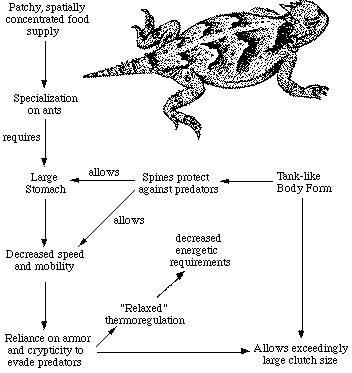 Possession of such a large gut necessitates a tank-like body form, reducing speed and decreasing the lizard's ability to escape from predators by flight. As a result, natural selection has favored a spiny body form and cryptic behavior rather than a sleek body and rapid movement to cover (as in the majority of other species of lizards). Risks of predation are likely to be increased during long periods of exposure while foraging in the open. A reluctance to move, even when actually threatened by a potential predator, could well be advantageous. Movement might attract attention of predators and negate the advantage of concealing coloration and contour. Such decreased movement doubtless contributes to the observed high variance in body temperature of Phrynosoma platyrhinos which is significantly greater than that of all other species of sympatric lizards. 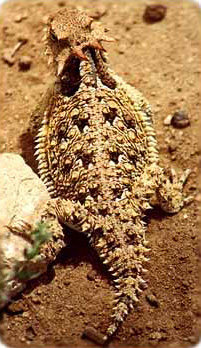 Phrynosoma platyrhinos is also active over a longer time interval than any sympatric lizard species. Wide fluctuations in horned lizard body temperatures under natural conditions presumably reflect both the long activity period and perhaps their reduced movements into or out of the sun and shade (the vast majority of these lizards are in the open sun when first sighted). More time is thus made available for activities such as feeding. A foraging anteater must spend considerable time feeding. Food specialization on ants is economically feasible only because these insects usually occur in a clumped spatial distribution and hence constitute a concentrated food supply. Horned lizards trapline from ant mound to mound and eat over 200 ants a day.
Phrynosoma platyrhinos is also active over a longer time interval than any sympatric lizard species. Wide fluctuations in horned lizard body temperatures under natural conditions presumably reflect both the long activity period and perhaps their reduced movements into or out of the sun and shade (the vast majority of these lizards are in the open sun when first sighted). More time is thus made available for activities such as feeding. A foraging anteater must spend considerable time feeding. Food specialization on ants is economically feasible only because these insects usually occur in a clumped spatial distribution and hence constitute a concentrated food supply. Horned lizards trapline from ant mound to mound and eat over 200 ants a day.
To make use of this patchy and spatially concentrated, but at the same time not overly nutritious, food supply, P. platyrhinos has evolved a unique constellation of adaptations that include a large stomach, spiny body form, an expanded period of activity, and "relaxed" thermoregulation (eurythermy). The high reproductive investment of adult horned lizards is probably also a simple and direct consequence of their robust body form. Lizards that must be able to move rapidly to escape predators, such as whiptail lizards (Cnemidophorus), would hardly be expected to weight themselves down with eggs to the same extent as animals like horned lizards that rely almost entirely upon spines and camouflage to avoid their enemies. Convergent Evolution and Ecological Equivalents Organisms filling similar ecological niches in different, independently-evolved, biotas are termed "ecological equivalents." Such convergent evolutionary responses of lizards to desert environments, although imperfect, are evident between continents. As a striking example, Australian and North American deserts both support cryptically-colored and thornily-armored ant specialized species: the agamid Moloch horridus exploits this ecological role in Australia, while its counterparts, Phrynosoma, occupy the role in North America. No other desert lizards have adopted such a life style, anywhere else on Earth. British naturalist W. Saville-Kent kept Moloch in captivity in the late 1890's before anyone had studied Phrynosoma. He discovered that these bizarre agamid lizards fed almost exclusively on ants and made various observations on their natural history. Noting the striking morphological similarity between Moloch and the North American genus Phrynosoma, Saville-Kent predicted that members of the latter genus would be ant specialists. His prediction proved quite correct. 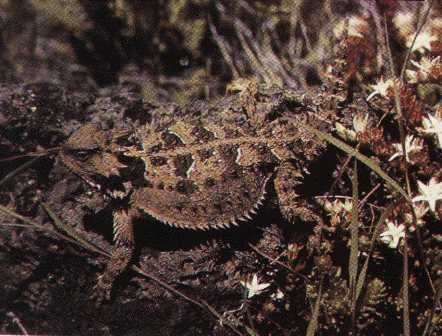 Conservation Many features of the horned lizard adaptive suite outlined above show how well suited these lizards are to their natural environment. They are a variable group of lizards and live in a wide variety of habitats and geographic regions. Unfortunately, when removed from their habitat or if their habitat is altered, horned lizards soon perish. In 1967, the progressive Texas legislature passed protective legislation preventing collection, exportation and sale of Phrynosoma cornutum from the state. Prior to this legislation, hundreds of thousands of horned lizards were exported (dead and alive) from Texas every summer to tourists, curiosity seekers and would be pet owners, leading only to demise of the lizards. 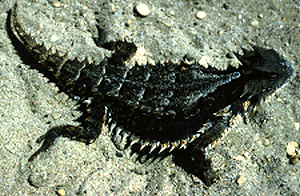 If a horned lizard has adequate fat reserves, it can live for months in an inadequate captive environment. These lizards are notoriously difficult to maintain for any length of time in captivity, however. Most species are now protected by state laws from general collection, although the state of Nevada still ignorantly allows commercial exploitation of Phrynosoma. Kids earn 25 cents to $1.00 for each lizard which commercial merchants turn around and resell for $20-30 to hobbyists. Nice profit margin, but certain death for almost all the collected lizards. Mexican nationals also find Phrynosoma irresistible as "pets" and they collect and attempt to keep them in captivity in higher numbers than ever. Phrynosoma are becoming prevalent in Mexican markets throughout the country despite limited federal protection. 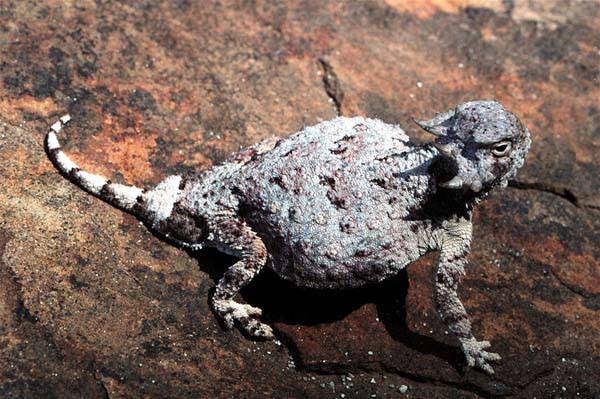 Habitat alteration occurs at a variety of levels. Housing developments do not always mean certain demise of horned lizards if native vegetation is kept and other pets, such as dogs and cats are not allowed. Many small Texas towns rightfully boast of their amazing horned lizard populations. But, generally developments mean planting non-native grasses which completely cover the ground, choking out native plants and preventing the lizards access to dirt to bury in or dig their burrows or lay eggs. Along with developments, generally come a new set of animals not native to the area. The spread of ravens throughout the deserts, blue jays, dogs, and cats are promoted by human invasion. These animals follow humans around. Trash pits become havens and resources to increase not only avian predators, but canine predators as well. Habitat alteration can also take the form of agricultural conversion or conversion to pastureland. Habitat alteration in Texas and the southeastern United States has promoted the spread of a terrible introduced pest, Solenopsis invicta, the red imported fire ant. These ants, accidentally introduced from South America, pose a significant threat to all wildlife in the southern United States. Fire ants can kill almost anything given the chance and they are fierce competitors against native ants which horned lizards require for food. Horned lizards do not eat fire ants probably due to the ants' different natural history than the native harvesting ants, different venom in the sting apparatus and different nutritional component. The widespread invasion of fire ants have given all ants a very bad reputation. Since the early 1950s, broadcast pesticides have been used to combat ants and other pest insects, including mosquitoes and crop pests. Homeowners regularly use ant insecticides to kill all ants on their property thereby making it even easier for fire ants to invade because they have nothing to stop them. Such practices also demolish the food supply for horned lizards. The Horned Lizard Conservation Society (P.O. Box 122, Austin, Texas, 78767) was formed in 1990 to try to stop the decline of horned lizards in North America. 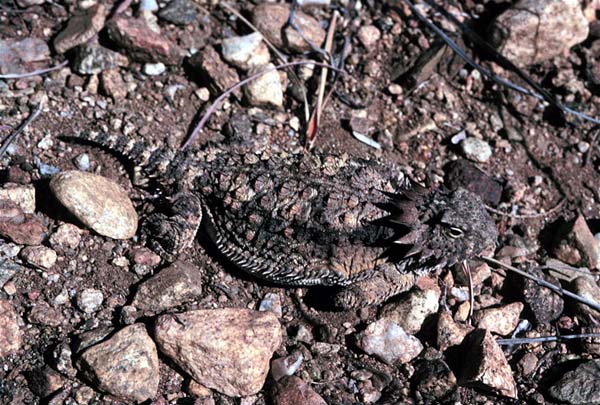 Horned lizards are unique lizards in the world. They were here long before humans and have evolved through many millions of years of environmental changes. Unfortunately, horned lizards cannot cope with the rapid, drastic human modifications of the landscape occurring today. Protecting natural areas and reducing human impact on those areas is vital for the continuance of horned lizards to be a part of the human experience. Moreover, observing wild horned lizards in their natural environments is even more rewarding than watching them sit captive in small terrariums. References/Suggested Reading Donaldson, W. L., A. H. Price, and J. Morse. 1994. The Current Status and Future Prospects of the Texas Horned Lizard (Phrynosoma cornutum) in Texas. Texas Journal of Science 46(2) 97-113. Funk, R.S. 1981. Phrynosoma mcallii (Halowell): Flat-tailed horned lizard. Cat. Amer. Amph. Rept. pp. 281.1-281.2. Hodges, W.L. 1995. Phrynosoma ditmarsi Stejneger: Rock Horned Lizard. Catalogue of American Amphibians and Reptiles. pp. 614.1-614.3 Hodges, W.L., Zamudio, K.R., 2004. Horned lizard (Phrynosoma) phylogeny inferred from mitochondrial genes and morphological characters: understanding conflicts using multiple approaches. Mol. Phylogent. Evol. 31: 961-971. Jennings, M. R. 1988. Phrynosoma coronatum (Blainville): Coast horned lizard. Cat. Amer. Amph. Rept. pp. 428.1-428.5. Jennings, M. R. 1988. Phrynosoma cerroense (Stejneger): Cedros Island horned lizard. Cat. Amer. Amph. Rept. pp. 427.1-427.2 Leache, A.D. and J. A. McGuire. 2006. Phylogenetic relationships of horned lizards (Phrynosoma) based on nuclear and mitochondrial data: Evidence for a misleading mitochondrial gene tree. Molecular Phylogenetics and Evolution 39: 628-644. Manaster, J. 1997. Horned Lizards. University of Texas Press, Austin, Texas. Montanucci, R. R., 1989. The relationship of morphology to diet in the horned lizard genus Phrynosoma. Herpetologica 45: 208-216 Montanucci, R. R., 1987. A phylogenetic study of the horned lizards, genus Phrynosoma, based on skeletal and external morphology. Contrib. Sci., Nat. Hist. Mus. L.A. Co. 390:1-36 Parker, W.S. 1974. Phrynosoma solare (Gray): Regal horned lizard. Cat. Amer. Amph. Rept. pp. 162.1-162.2. Pianka, E. R. 1991. Phrynosoma platyrhinos. Girard: Desert Horned Lizard. Catalogue of American Amphibians and Reptiles. pp. 517.1-517.4. Pianka, E. R. and W. S. Parker. 1975. Ecology of horned lizards: A review with special reference to Phrynosoma platyrhinos. Copeia 1975: 141-162. Download pdf Price, A. H. 1990. Phrynosoma cornutum (Harlan): Texas Horned Lizard. Catalogue of American Amphibians and Reptiles. 469.1-469.7. Reeve, W. L. 1952. Taxonomy and distribution of the horned lizard genus Phrynosoma. Univ. Kansas Sci. Bull. 34: 817-960. Sherbrooke, W. C. 1981. Horned lizards, unique reptiles of western North America. Southwest Parks & Mon. Assoc., Globe, Ariz. 48 pp. Smith, H. M. 1946. Handbook of lizards: Lizards of the United States and of Canada. Comstock Publishing Co. Ithaca, New York. Welch, J. R. 1993. O Ye legendary Texas Horned Frog! Yellow Rose Press. Irving, Texas. Zamudio, K. R., K. B. Jones, and R. H. Ward. 1997. Molecular systematics of short-horned lizards: biogeography and taxonomy of a widespread species complex. Systematic Biology 46: 284-305. |